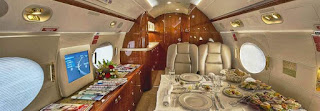https://centraljetcharter.com/turboprop-aircraft.html
Piston engines, also known as reciprocating engines, are descendents of steam engines which first appeared in the early 17th century.
In simple terms, steam engines use heat to produce steam pressure, which in turn is used to generate rotating motion.
Steam engines were eventually used to drive everything from mechanical equipment to the first railway trains. In today’s aircraft piston engines, gas propulsion replaces steam in creating pressure within the engine.
"Turboprop Aircraft Flights"
turboprop aircraft, charter flights, aircraft charter, interior private Aircraft
Piston engines are characterized by one or more cylinders, each containing a snugly fitting piston (a solid cylinder) which is able to move freely back and forth within the cylinder. Each piston is connected to a crankshaft, via a connecting rod (or 'piston rod').
Turboprop aircraft, which are powered by a close relative of the turbine engine, are another animal entirely.
A turbine – which is simply another word for ‘fan’ – is exactly that: a rotary driven fan that derives energy from fluid flow or airflow.
The power of a turbine engine almost always allows turboprop aircraft to travel at higher speeds than piston aircraft.
And as turboprop aircraft cabins are typically pressurized these planes also commonly fly at higher altitudes.
Piston engines, also known as reciprocating engines, are descendents of steam engines which first appeared in the early 17th century.
In simple terms, steam engines use heat to produce steam pressure, which in turn is used to generate rotating motion.
Steam engines were eventually used to drive everything from mechanical equipment to the first railway trains. In today’s aircraft piston engines, gas propulsion replaces steam in creating pressure within the engine.
"Turboprop Aircraft Flights"
turboprop aircraft, charter flights, aircraft charter, interior private Aircraft
Piston engines are characterized by one or more cylinders, each containing a snugly fitting piston (a solid cylinder) which is able to move freely back and forth within the cylinder. Each piston is connected to a crankshaft, via a connecting rod (or 'piston rod').
Turboprop aircraft, which are powered by a close relative of the turbine engine, are another animal entirely.
A turbine – which is simply another word for ‘fan’ – is exactly that: a rotary driven fan that derives energy from fluid flow or airflow.
The power of a turbine engine almost always allows turboprop aircraft to travel at higher speeds than piston aircraft.
And as turboprop aircraft cabins are typically pressurized these planes also commonly fly at higher altitudes.




Comments
Post a Comment